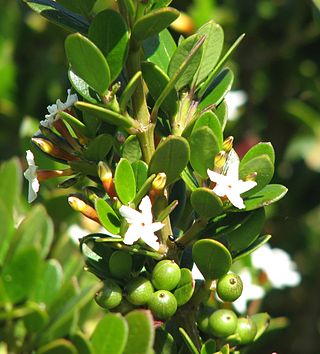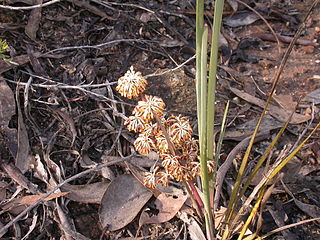
Hydrocotyle ranunculoides, known commonly as floating pennywort, or floating marshpennywort, is an aquatic plant in the family Apiaceae. It is native to North and South America.

Austrostipa is a primarily Australian genus of plants in the grass family, commonly called speargrass.

Callitris endlicheri, commonly known as the black cypress pine, is a species of conifer in the family Cupressaceae. It is found only in Australia, occurring in Queensland, New South Wales, the Australian Capital Territory, and Victoria.

Callitris monticola, commonly known as the steelhead or dwarf cypress, is a species of conifer in the family Cupressaceae. It is found only in Australia, occurring in the states of Queensland and New South Wales and is considered vulnerable due to its restricted distribution.

Andropogon virginicus is a species of grass known by several common names, including broomsedge bluestem, yellowsedge bluestem and whiskey grass. It is native to the southeastern United States and as far north as the Great Lakes. It is known as an introduced species in California and Hawaii, where it is weedy.

Leucopogon parviflorus, commonly known as coast beard-heath or native currant, is a shrub or small tree in the family Ericaceae. It is native to all Australian states and territories excluding the Northern Territory and the ACT and also grows in New Zealand. The species can grow to between 1 and 5 metres in height and has leaves that are 11 to 29 mm long and 2.4 to 7.5 mm in width, often with curved tips. The white flowers are around 15 mm long and are produced in spikes of 7 to 13. These occur throughout the year.

Ewartia planchonii, commonly known as creeping cushionherb, is an endemic herb to alpine areas of Tasmania. E. planchonii is commonly found in the western highlands of Tasmania. The Ewartia genus is described as cushion plants/herbs due to the characteristic growth habits of low growing, highly compact mats which are made up of highly packed stems. These mats are slow-growing and are often located in soils that contain low nutrients.
Austrostipa variabilis is a species of grass in the family Poaceae that grows in southern parts of Australia.
Austrostipa crinita is a species of grass that grows in coastal parts of midwest Western Australia.

Alyxia buxifolia, otherwise known as the sea box or dysentery bush, is a species of evergreen shrub in the family Apocynaceae.

Synemon theresa, the Cryptic Sun-moth, is a species of day-flying moth of the family Castniidae. It was described by Edward Doubleday in 1846. It has a wingspan of 26-40mm, and is mostly grey-brown with orange hindwings. Native to Australia, this species is extinct in Victoria, and is now only known from a relatively small area of South Australia near Adelaide. It uses Themeda triandra and Rytidopserma spp. as larval food plants. Adults can be found from December to February. They only live for a few days, as they do not have a feeding proboscis. Despite becoming extinct over much of its former range, the Cryptic Sun-moth is not listed as a threatened species in South Australia.
Austrostipa compressa, the compact needlegrass, originally described as Stipa compressa, is a species of grass that grows in south west Western Australia.

Lomandra effusa is a perennial, dioecious, rhizomatous herb native to Australia. It is a perennial tussock with bluish green, large, arching leaves which are distinctive by the two toothed leaf tip. It has white, cream or pink fragrant flowers during the months of June to October.

Lomandra multiflora is a perennial, rhizomatous herb found in Australia. Lomandra multiflora is also commonly known as many-flowered mat rush, mat rush and many flowered mat-lily. Lomandra multiflora is a species that is native to Australia and can be found in New South Wales, Queensland, Victoria, South Australia, Northern Territory of Australia and also in Papua New Guinea. The mat rush is distributed widely in the region and common within its preferred growing conditions. The conservation status of Lomandra multiflora is considered not to be of concern and risk.

Trochocarpa gunnii, commonly known as sweet-scented trochocarpa or fragrant purpleberry, is a common rainforest understorey shrub from the plant family Ericaceae endemic to Tasmania.

Triodia scariosa, is more commonly known as porcupine grass or spinifex, and belongs to the endemic Australian grass genusTriodia. The species is perennial and evergreen and individuals grow in mounds, called hummocks, that reach up to ~1m in height. The leaves are ~30 cm long, 1mm in diameter, needlepointed and rigid, and its inflorescence is a narrow, loose panicle that forms a flowering stalk up to ~2m in height. The name is derived from Latin; Triodia refers to the three-toothed lobes of the lemma, and scariosa is in reference to the thin, dry glume. The species is common to Mallee (MVG14) and Hummock grassland (MVG20) communities, in arid and semi-arid regions of Australia.

Acacia latzii, also known as Latz's wattle and Tjilpi wattle, is a shrubby tree of the genus Acacia. It is native to the Finke bioregion.
Will Bonsall is an American author, seed saver and veganic farmer who lives in Maine. He is a regular speaker about seed saving, organic farming and veganic farming.

Austrostipa mollis, also known as the soft speargrass or supple speargrass is a robust, erect tufted perennial speargrass in the Poaceae family. It is native to Australia, and found in Western Australia, South Australia, Victoria, ACT and Tasmania.

Trygonorrhina dumerilii, the southern fiddler ray, is a species of cartilaginous fish in the Rhinobatidae family. The species is medium-sized with mainly yellow, black, and white colours. T.dumerilii has a maximum size of 1 m, and is common in southern Australia and also the eastern parts of the Bass Strait. T.dumerilii is rated least concern on the IUCN Red List.















